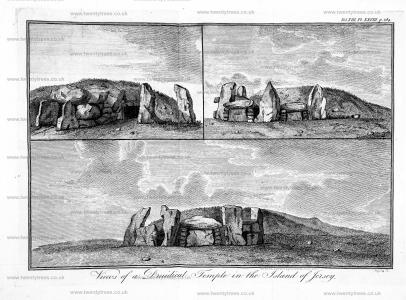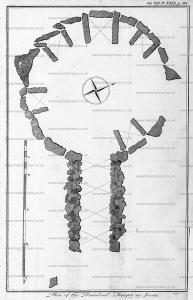Archaeologia Volume 8 Section XXXV
Archaeologia Volume 8 Section XXXV is in Archaeologia Volume 8.
Description of a Druidical Monument [La Hogue Bie [Map]] in the Island of Jersey; in a Letter from the Right Honourable Henry Seymour. Conway (age 63), Governor of Jersey, to the Earl of Leicester, P. S. A. Read March 8, 1787.
My Lord
I have the honour to tranfmit herewith the model of a Druid Temple, discovered some time ago on the top of a pretty high rocky hill, near the town of St. Helier, in the Island of Jersey. I am sorry to have so long delayed executing the promise I made to send it your lordship; but it having been transmitted to me without a scale, I did not care to trouble you till that material defect was remedied. By the scale which I have now received, and which is of three feet to an inch, your lordship will see the dimensions are not great, but I imagine it to be the most intire and perfect monument of this kind existing in this part of the world.
I shall not attempt to say any thing of the nature or use of these extraordinary structures; your lordship and the gentlemen of your learned Society having full knowledge of all that can be said on the subject.
By the very imperfect accounts we have of the history and antiquities of that island, there is reason to think it has been very particularly the seat of the Druids and their worfhip. Mr. Bindextre, who wrote some tracts on the affairs of Jersey, and died in the year 1691, says, there were existing in that small island no less than fifty of these Druid temples, or altars, in his time; of which the greater part were demolished when Falle published his History of Jersey pretty early in the present century. He mentions a single altar of large dimensions then standing on the same hill of St. Helier, the top stone of which was fourteen feet long, seven and an half broad, and three in thickness, and near it a circle of other stones, of which there remained remained but one when he wrote, the rest having been broken to make a wall hard by.
From the above it is plain that the prefent complete structure was not known at that time, though there was another large altar, or temple, and another circle of stones, seen on the same hill.
The present temple remained intirely covered with earth till the summer 1785; having the appearance of a large barrow or tumulus, in which form I had constantly feen it when in the island. It then happened that the colonel of the St. Helier's militia wanting to level the ground for the exercise of his corps, the workmen soon struck on the stones, and the temple thus discovered was afterwards cleared as it now stands.
There is no trace of the time when it was covered up; not improbably in that of the Romans, by the Druids themselves, to preserve it as their most sacred temple from the violence or profanation of that people, who frequently persecuted them, and who certainly had possession of the island, as appears from its Latin name of Ceasarea, and from several names, and some small vestiges remaining, as well as from the coins found pretty often in different parts of the island.
I do not know whether it may be thought of any consequence to mention the particular position of the temple, or the bearings of the several cells, or altars, respectively; but, knowing it is the opinion of some learned persons that they are objects worthy of some consideration, I had them taken, and herewith sub-join a ground-plan of the whole, set out to the points of the compass; as also three drawings of the temple, as it appeared soon after the discovery, together with a plan of it [a].
Note a. ee Plates XXVIII. XXIX.


There have very lately been discovered, as my lieutenant governor informs me, five graves on the same hill, and about 170 feet from the temple; one of them has, he says, somewhat of a curved form, but that they have no other peculiarity except that of their being lined with a kind of rubble stone.
The above are the chief particulars I have been able to learn on this subject, and I shall be happy if they give any satisfaction to your Lordship, or the Society. I am, my lord, with great esteem, your lordship's most faithful and obedient servant,
H. S. CONWAY.
Little Warwick Street, Feb. 20, 1787.